Laptop Mag Verdict
The Razer Blade 14 combines long battery life and excellent graphics performance in a slim and sexy design for a great mobile gaming experience.
Pros
- +
Sexy, lightweight chassis
- +
Extremely portable
- +
Excellent graphics and performance
- +
Comfortable, fully programmable keyboard
- +
Long battery life
Cons
- -
Runs hot while gaming
- -
Limited viewing angles
- -
Lacks SD card slot
Why you can trust Laptop Mag
With the Blade 14, Razer remains on the cutting edge of gaming notebooks. Currently the world's thinnest gaming laptop, the Blade 14 offers more than just a slim, soft-touch chassis. This machine also crams a fourth-generation Intel Core i7 processor and an Nvidia GeForce GTX 765M GPU into a svelte, 0.66-inch frame. Is this portable gaming experience worth the $1,999 price tag?
Design
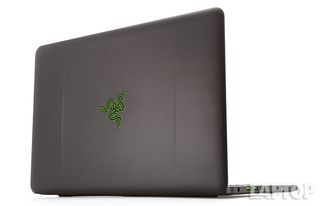
Click to EnlargeThe Blade 14 retains the alluring design of its big brother, the second-generation Razer Blade. We're still fans of the black aluminum chassis, which is both stylish and lightweight. The center of the lid is dominated by Razer's hypnotic three-headed snake logo, tantalizingly backlit in green. The insignia sits between two elegant ridges, which give the notebook a muscle-car aesthetic.
Additional luscious black aluminum greets you as you open the notebook. The keyboard deck is nestled between a pair of speakers, below the black power-button. A massive touchpad sits below the keyboard, with a pair of skinny, discrete mouse buttons. A deep row below the touchpad provided enough space to fit our finger beneath it and easily open the notebook.
MORE: Best Laptops
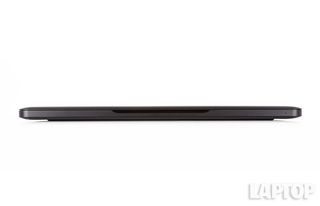
Click to EnlargeThe 4.2-pound, 13.6 x 9.3 x 0.66-inch Razer Blade 14 currently holds the title as the world's thinnest gaming notebook. By comparison, the Alienware 14 weighs 6.6 pounds and measures 13.2 x 10.2 x 1.57-1.62 inches. The MSI GE40 20C-009US weighs the same as the Razer but is a thicker 13.2 x 9.4 x 0.8 inches.
Display
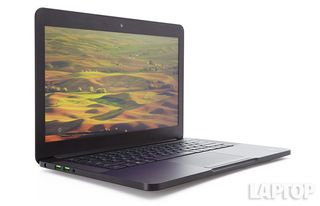
Click to EnlargeThe Blade 14 features a bright matte, 1600 x 900 display. Other rigs in this class offer full HD 1080p displays, but on the Blade 14's screen, we could still see nearly every strand of Thorin's messy tresses in the high-def trailer of "The Hobbit: The Desolation of Smaug." However, Legolas' deep-blue eyes looked slightly washed out, as did Tauriel's usually flame-red mane.
The Blade 14's screen impressed during our "Tomb Raider" playthrough. The flames flickered in a realistic reddish-orange. The jungle backdrop helped to accentuate the look with its deep greens, rich browns and opulent yellows. Likewise, waterfalls and pools looked gorgeous, along with the accompanying mist effects.
Regardless of what you're watching, viewing angles could be better. The screen washes out if you're sitting anywhere past 45 degrees.
Registering 323 lux on our light meter, the Blade 14 easily topped the 209-lux average for the thin-and-light category. The GE40's 1600 x 900 display notched 204 lux, while the Alienware 14's 1080p display scored 161 lux.
Audio
The Blade 14's Stereo 2.0 speakers are paired with Dolby's Home Theater v4 software, a setup that results in loud, crisp audio that can fill a small room. When we listened to Queen's "Don't Stop Me Now," Freddie Mercury's vocal was front and center, and were the backing piano, guitar, drums and tambourines were equally clear. However, low notes were very faint, forcing us to strain to hear this register. We ran into the same problem on Kanye West's "Blood on the Leaves," rendering the track's usually thundering bass virtually silent.
The audio while we played "Tomb Raider" was warm and immersive, ably balancing dialog, music and sound effects. As we navigated through a burning ruin, we could hear the crackling of the flames and the creaking of the deteriorating wood, as well as the angry screams of the crazed islanders. The speakers also ably handled more nuanced sounds, such as the tightening of a bow string or the harried breathing of our heroine.
During our testing of the Dolby software, the Music setting delivered the best audio, compared to the Game and Movie settings.
Keyboard and Touchpad
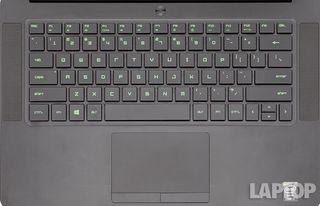
Click to EnlargeThe Blade 14's island-style, backlit keyboard glows an eerie, but sexy green that's plenty bright enough to work in a dimly lit room. The black, flat keys are large and well spaced, delivering springy feedback when a user is typing. We scored 62 words per minute on the Ten Thumbs Typing Test, higher than our usual 55 wpm.
Razer's Synapse 2.0 software makes every key programmable. The keyboard also has anti-ghosting (multiple key presses are recognized simultaneously), so gamers can seamlessly run and gun.
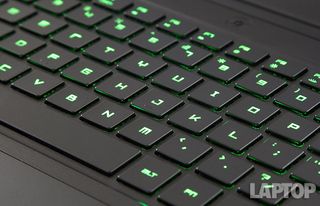
Click to EnlargeThe laptop's 4.2 x 2.5-inch Synaptics touchpad is plenty large and responsive. It has a smooth, almost silky quality, making the overall experience comfortable. When we performed Windows 8 and multitouch gestures (including two-finger scroll, pinch-zoom and four-finger swipe), the Blade 14 was fast and responsive.
While we appreciate the touchpad's size, the large surface leaves precious little space for the discrete mouse buttons. These buttons are slimmer than we prefer, but still delivered firm, snappy feedback.
Synapse 2.0
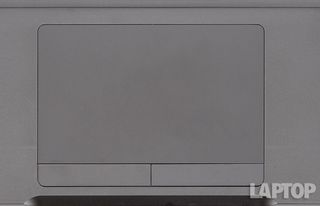
Click to EnlargeSynapse 2.0, Razer's cloud-based configuration software, comes pre-installed on the Razer Blade 14. This software enables users to customize settings, such as mouse sensitivity and keyboard and display brightness. Users can also create profiles for the keyboard, including custom macros.
We created a custom keyboard profile for "Borderlands 2" using Synapse. After mapping out our keys (G for Grenades and F for Special Powers), we linked the profile to the Borderlands.exe file. From there, Synapse 2.0 would launch our custom profile every time we launched the title.
Synapse 2.0 also stores your profiles in the cloud. This eliminates the need to recreate them every time you use a new notebook or mouse.
Heat
The Blade 14 kept cool during non-gaming activities. After streaming a full-screen video on Hulu for 15 minutes, we measured a temperature of 85 degrees Fahrenheit on the notebook's touchpad. The space between the G and H keys registered 90 degrees, while the notebook's undercarriage hits 89 degrees. The space within the hinge along the bottom of the laptop measured 91 degrees, a few degrees shy of our 95-degree comfort threshold.
When we started playing "Tomb Raider," Razer's custom-designed heat pipe kicked in, directing the heat away from commonly touched areas on the notebook to the space between the display and the hinge. Still, the aluminum-clad chassis remained too hot for laptop gaming. The touchpad measured 98 degrees, while the space between the G and H keys reached 113 degrees. The bottom of the notebook hit a scorching 125, as did the space between the hinge and the display.
Webcam

Click to EnlargeImages and video taken with the 1.3-megapixel webcam were rather dark, even in ideal, natural lighting situations. Our test shots exhibited faded colors, specifically in our colorful plaid shirt. Our shots also lacked detail, as evidenced by the fuzziness around the lace of our tank top.
Ports
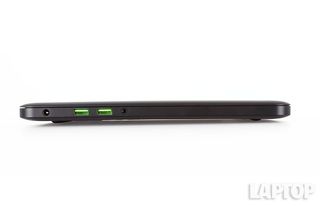
Click to EnlargeAlthough the Blade 14 is a super-thin system, gamers still need a few ports with which to connect peripherals, such as gaming mice. The right side of the Blade 14 houses a single USB 3.0 port, HDMI and a secure lock slot. Along the left side of the notebook, sit two more USB 3.0 ports, a headset jack and an AC adapter jack. Unfortunately, Razer couldn't find room for an SD Card slot.
Graphics and Gaming
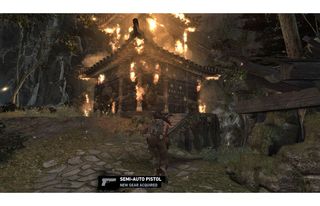
Click to Enlarge
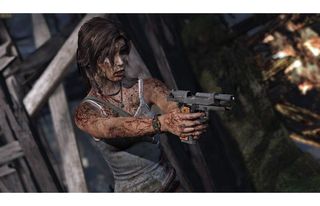
Click to EnlargeThe Razer Blade can frag with the best of them. Thanks to its Nvidia GeForce GTX 765M GPU with 2GB of VRAM, gamers can play most of the graphically taxing titles on the market.
We put the Blade 14 through its paces during our "Tomb Raider" playthrough, adjusting the graphics settings to test the machine's limits. We started on Low at 1600 x 900 at 60Hz], while disabling V-Sync, which netted us an average frame rate of 140 fps. When we ramped effects up to Normal, the notebook got an average 97 fps, while High delivered 74 fps. The system was still kicking at Ultra, delivering a smooth 43 fps. Ultimate is about the limit for the Blade 14; at this setting, the game began to stutter noticeably, and frame rates dropped to 29 fps, just below our 30 fps playability threshold.
The laptop scored an impressive 4,060 on the 3DMark11 benchmark. That's a whopping 2,837 points above the 1,223 thin-and-light average. The MSI GE 40's Nvidia GeForce GTX 760M GPU notched 3,498, but the Alienware 14 scored a slightly higher mark of 4,136 with the same GPU as the Razer.
When we ran the "World of Warcraft" benchmark at maximum settings, the Blade 14 averaged 92 fps at its native resolution. The GE40, which has the same resolution display as the Razer, managed 88 fps at these same settings, while the Alienware 14 delivered 84 fps with its display at 1080p.
The Blade 14 held its own during the "Bioshock Infinite" test, averaging 107 fps at 1366 x 768 on Low. That's well above the GE40 (80 fps), but the Alienware 14 notched a higher 111 fps. With the resolution at 1366 x 768, but with the effects at maximum settings, the Blade 14's frame rate dropped to 38 fps. The Alienware 14 scored 40 fps, while the GE40 notched 34 fps.
At its native 1600 x 900 resolution, the Blade 14 returned a just-playable 30 fps on Bioshock, topping the 18 fps average and the GE40's 27 fps. The Alienware 14 managed 24 fps at its higher native resolution of 1080p.
Performance

Click to EnlargeNever underestimate the power of a thin-and-light laptop. The Razer Blade 14's fourth generation 2.2-GHz quad-core Intel Core i7-4702HQ CPU with 8GB of RAM can certainly run with the big boys. During the PCMark 7 benchmark, the notebook scored 5,873, easily surpassing the 3,058 thin-and-light category average. Powered by 2.4-GHz Intel Core i7-4700MQ processors, the MSI GE40 and Alienware 14 notched scores of 5,345 and 5,325, respectively.
The Blade 14's 256GB SSD booted Windows 8 in 7 seconds, twice as fast as the GE40 (15 seconds). The Alienware 14 booted Windows 7 in 30 seconds.
The SSD was equally fast on other tests, duplicating 4.97GB of multimedia files in 36 seconds. That translates into a transfer rate of 141.4 MBps, nearly 100MBps faster than the 44 MBps category average. This showing was enough to blow past the GE40 (127.2 MBps), but it fell short of the Alienware 14's remarkable 203.6 MBps.
During the OpenOffice Spreadsheet Macro Test, the Blade 14 matched 20,000 names with their corresponding addresses in 4 minutes and 15 seconds. While that's much faster than the 5:56 category average, the GE40 and the Alienware 14 were slightly faster at 4:13 and 4:00, respectively.
Battery Life
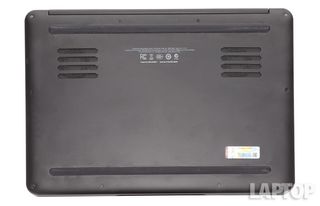
Click to EnlargeUsing Nvidia's Optimus technology, the Razer Blade 14 switches to its integrated Intel HD Graphics 4600 GPU for less-intensive tasks. On the Laptop Battery Test (continuous Web surfing over Wi-Fi), the Razer Blade 14 lasted 8 hours and 7 minutes. That's nearly 2 hours longer than the 6:11 thin-and-light average, and almost 3 hours longer than the Alienware 14 (5:17). However, the MSI GE40, which also uses Nvidia's Optimus technology, outlasted both machines, with a runtime of 8:20.
MORE: 10 Laptops with the Longest Battery Life
Software and Warranty
Bloat, what bloat? Aside from Razer Synapse 2.0 software and Dolby's audio software, Razer has kept the Windows 8 install on this system delightfully clean.
The Razer Blade 14 comes with a 1-year standard warranty.
Configurations
Our $1,999 review unit features a 2.2-GHz Intel Core i7-4702HQ CPU, 8GB of RAM, a 256GB SSD, an Intel HD Graphics 4600 GPU and an Nvidia GeForce GTX 765M GPU with 2GB of VRAM. The $1,799 base model has similar specs but uses a 128GB SSD, while the $2,299 edition bumps the drive up to 512GB.
Verdict
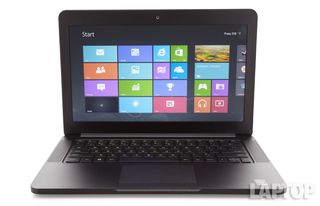
Click to EnlargeRazer has churned out a sexy and powerful gaming laptop with an amazingly slim profile. The Blade 14's high-end specs allow it to trade shots with heavyweights without breaking a sweat. We also love the customizable, backlit keyboard and more than 8 hours of battery life (when you're not gaming). We just wish this rig kept its cool better during gaming and that it came with a 1080p display.
Those looking to save some cash might prefer the $700-cheaper MSI GE40, which offers performance that's almost as good as the Razer, in an equally portable -- but less sexy -- package. The similarly priced (but heavier) Alienware 14 boasts a full HD screen and more cool lighting-effects. Still, gamers who want the best performance in the smallest package should choose the Razer Blade 14.
Razer Blade 14 Specs
| Brand | Razer |
| CPU | 2.2-GHz Intel Core i7-4702HQ Quad Core Processor |
| Company Website | www.razerzone.com |
| Display Size | 14 |
| Graphics Card | Intel HD Graphics 4600/Nvidia GeForce GTX 765M |
| Hard Drive Size | 256GB |
| Hard Drive Speed | n/a |
| Hard Drive Type | SSD Drive |
| Native Resolution | 1600x900 |
| Operating System | Windows 8 |
| Optical Drive | None |
| Optical Drive Speed | n/a |
| Ports (excluding USB) | HDMI, Combo Headphone/Mic Jack |
| RAM | 8GB |
| Size | 13.6 x 9.3 x 0.66 inches |
| Touchpad Size | 4.2 x 2.5 inches |
| USB Ports | 3 |
| Video Memory | 2GB |
| Weight | 4.2 pounds |

Sherri L. Smith has been cranking out product reviews for Laptopmag.com since 2011. In that time, she's reviewed more than her share of laptops, tablets, smartphones and everything in between. The resident gamer and audio junkie, Sherri was previously a managing editor for Black Web 2.0 and contributed to BET.Com and Popgadget.